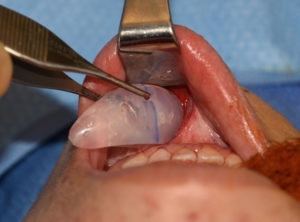Chin augmentation through the use of an implant is an historic procedure that dates back over fifty years and is still commonly performed today. It is typically done with a silicone chin implant due to its wide variety of styles and sizes and its smooth surface which facilitates its insertion and placement.
A chin implant can be inserted from either above or below the chin, each with its own distinct advantages and disadvantages. The submental or under the chin technique uses a skin incision to access the chin bone to make the subperiosteal pocket. It has the advantage of not disrupting the origin of the mentalis muscle attachments, has a lower risk of potential implant contamination and ensures a more desired lower implant position on the bone. Its lone disadvantage is the concern about the scar appearance which usually heals very well. It is the more commonly use chin augmentation technique.
The intraoral chin implant technique approaches the chin bone from above. Its lone advantage is that it is a scarless chin augmentation. It has to disrupt the mentalis muscle bone attachments to create the subperiosteal pocket down to the bottom of the chin bone. Without screw fixation there is a risk of the implant sliding upward towards the direction from whence it was placed after wound closure. In theory it is the more contaminated approach although there are no studies that validate the intraoral approach is associated with a higher rate of infection than the submental route.

Dr. Barry Eppley
Indianapolis, Indiana


